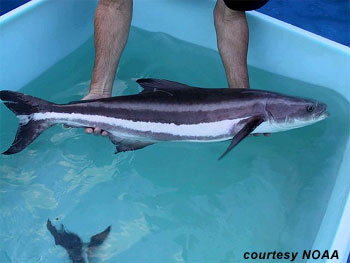The
"fish of the future" was unveiled at the European Seafood Exhibition in
Brussels earlier this year, writes TheFishSite senior editor Chris
Harris.
Marine Farms group through its
subsidiary in Viet Nam is starting to grow, farm and market Cobia, which
it describes as a versatile and unique food.
"It is a versatile fish that can be served raw, cooked or smoked and it
is easily prepared," said Marine Farms Viet Nam managing director Carlos
Massad.
"Unlike many fish, Cobia can be genuinely prepared equally successfully
in very different ways.
"The firm white flesh is easily and accurately sliced essential for the
sashimi and sushi markets, but Cobia is also appetising served roasted,
grilled, steamed or poached."
Marine Farms is based in Nha Trang where it has its farms for growing on
the fry to mature fish.
At present Marine Farms buys in the juveniles selected from wild brood
stock, from the Vietnamese Research Institute of Aquaculture 1.
The brood stock is then selected and held back from the current growing
season.
"We are slowly changing as we are developing our own fish and we hope to
have our own hatchery," said Mr Massad.
The fish hatch at 26C and there is a 12-18 month cycle from hatch to
harvest.
Mr Massad said the company had used its years of experience in
aquaculture world wide to research and develop the farming and growing
of the fish.
The fish have a growth rate three time that of farmed salmon - growing
from just two grams to five kilograms in a year.
The have a good feed conversion rate using low fat Atlantic salmon diet
without pigment.
Marine Farms uses non-genetically modified feed that is fully traceable
and no antibiotics are used at any time in the growth cycle.
"We use no land based animal protein in the feed at all and the feed is
imported from Chile and Canada," Mr Massad added.
The company says there is an on-going research programme to improve feed
conversion and to produce a more specific diet.
The company produces 1,500 tonnes of fish growing them out from two
grams to five kilos in ocean cages that are protected by islands.
The company has 10 sites with five used at any one time so that they can
be rotated for continual production. Marine Farms grows one generation
per farm site a year and after destocking the cages are taken from their
moorings to be cleaned and disinfected.
While at present the company is producing 1,500 tonnes of fish, it has
the capacity to produce 6,000 tonnes.
"Once we have developed the market we will be expanding production,"
said Mr Massad.
"When we reach 2.000 to 3,000 tonnes production we will need our own
hatchery."
The farms use a Norwegian system with 100 metre cages and they follow
strict protocols to keep the cages clean, because not only does the
system mean there is no antibiotic use, but there is also no antifouling
on the nets.
Marine Farms has a strict stocking density of a maximum of 10kg per
cubic metre and the company is aiming to become part of the WWF dialogue
on welfare measure for farmed fish.
The main market for the fish is Taiwan where they are sold whole for
sashimi.
The company sends the fish out to a Japanese company for processing and
the marketing process ensures that there is no waste because the fish is
an expensive product.

Copyright © www.TheFishSite.com - Reproduced with Permission |